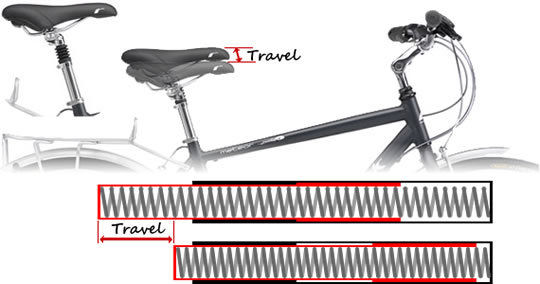Increasing Cycling Comfort... Suspension Seat Pillars

General Description...
A suspension seat pillar is one of the simplest methods of adding a degree of suspension to a bike.
Common and popular on many hybrid and leisure orientated bikes, they allow the saddle to move up and down by means of the seat pin/pillar telescoping.
In it's crudest form, a suspension seat pillar is two tubes, closed at one end, one inside the other so that the two closed ends form the ends of the result. A simple coil spring inside the inner tube forces the two ends apart elongating the pillar. When you sit on the sadle, your weight will partially compress the spring, shortening pillar. There will, generally, be some travel left in the spring such that as you ride over bumps, the spring compresses further, absobing some of the impact. This in turn means that the bump you feel in your bum is not as harsh as it would have been :-)
Better quality models may use synthetic elastomer springs or even hydraulic oil and pressuraised air filled dampers.
Common and popular on many hybrid and leisure orientated bikes, they allow the saddle to move up and down by means of the seat pin/pillar telescoping.
In it's crudest form, a suspension seat pillar is two tubes, closed at one end, one inside the other so that the two closed ends form the ends of the result. A simple coil spring inside the inner tube forces the two ends apart elongating the pillar. When you sit on the sadle, your weight will partially compress the spring, shortening pillar. There will, generally, be some travel left in the spring such that as you ride over bumps, the spring compresses further, absobing some of the impact. This in turn means that the bump you feel in your bum is not as harsh as it would have been :-)
Better quality models may use synthetic elastomer springs or even hydraulic oil and pressuraised air filled dampers.
Pros...
Simple and relatively cost effective way of smoothing out the bumps of everyday riding.
Effective for normal road use and well made offroad tracks like canal towpaths and bridleways.
Effective for normal road use and well made offroad tracks like canal towpaths and bridleways.
Cons...
Only limited travel. Typically between 1 and 2 inches.
The mechanism uses roughly 3 inches of the distance between your saddle and the top of the frame, so if your saddle is low to the frame anyway, the extra height may make the bike too big for you. You should be OK if there is already 3 inches of "gap" between the saddle and frame.
Basic models weigh considerably more than a standard seat pillar, though you are unlikely to notice the additional weight whilst riding.
Limited size availability. Make sure you get one that will fit your bike. Take your bike with you to the shop and ask them to fit it for you as it is quite tricky!
Many cheap models have such limited travel left once you've sat on them that they become pretty worthless! Look for ones with pre-tensioning adjustments.
The mechanism uses roughly 3 inches of the distance between your saddle and the top of the frame, so if your saddle is low to the frame anyway, the extra height may make the bike too big for you. You should be OK if there is already 3 inches of "gap" between the saddle and frame.
Basic models weigh considerably more than a standard seat pillar, though you are unlikely to notice the additional weight whilst riding.
Limited size availability. Make sure you get one that will fit your bike. Take your bike with you to the shop and ask them to fit it for you as it is quite tricky!
Many cheap models have such limited travel left once you've sat on them that they become pretty worthless! Look for ones with pre-tensioning adjustments.
Expect to Pay...
Basic models start from around £20 ranging up to £100 or more.
